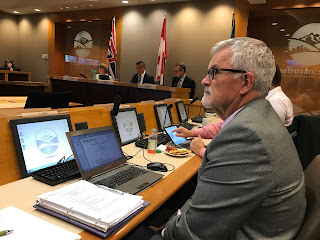 |
| Pride Flag: Strikingly similar to "diversity" crosswalk. |
And so, Coquitlam will now have its very own “rainbow” crosswalk, lovingly applied along a strip of pedestrian pavement directly south of city hall at the western side of the intersection of Pinetree Way and Burlington Avenue. The multi-hued fixture will surely
enliven the city hall precinct, even as it stands as a testament to some dubious decision-making and the power of virtue signalling.
Exactly what the rainbow crosswalk will officially stand for is still not quite settled. Reasonable folks, who are relatively familiar with recent history, might conclude that it is a sign of support for the Lesbian-Gay-Bisexual-Transexual-Questioning (LGBTQ) “community.” But the majority of council say this is not actually the case.
Rather, they say it is a sign of the city’s acceptance and even celebration of diversity. But, surely, such an assertion contradicts the rainbow crosswalk’s colourful history.
The idea to create rainbow crosswalks appears to have first emerged in West Hollywood as part of the 2012 Gay Pride Month celebrations. Why a rainbow? As Wikipedia says, “The rainbow flag or gay pride flag, is associated with the lesbian, gay, bisexual, and transgender (LGBT) community and LGBT activities around the world.”
The direct connection between the rainbow crosswalk and LGBT(Q) was just as clear when, in 2013, Vancouver unveiled Canada's first permanent rainbow crosswalk in the West End to help mark the city’s Pride Week. Councillor. Tim Stevenson explained that the crosswalk helped reflect the area's significance as the city’s “gay village”. He is
quoted by the Georgia Straight as saying, “This really does mark the strongest support the city has ever shown towards the GLBTQ community.”
Now, given that council has a longstanding policy not to issue proclamations in support of any specific group or cause, and given that the installation of a rainbow crosswalk would surely constitute a
de facto proclamation in support of the aforementioned “community,” one might conclude that Council would not, could not, and would never support the installation of said crosswalk.
But this is where it gets cute. When making her presentation to Council in Committee last month, Nicola Spurling argued that the rainbow crosswalk was not actually a symbol of support only for those identifying as LGBTQ, but was a “a universal symbol of acceptance…”
 |
| Rainbow Crosswalk: Pro-LGBTQ or pro-diversity? |
The majority of Council bought the argument but, even as they did, seemed to realize that many citizens might not view it so broadly, so they called for the crosswalk to be accompanied by an explanatory sign, that would say something like “diversity lives here.”
Hmmmm. I sincerely doubt that Council would have a similar reaction to, let’s say, a Christian group that came to council asking for crosswalk depicting Christ and his apostles –even though they might argue with great fervor and compelling rhetoric that Christ is a universal symbol of the power of love and peace, and what the world needs now is, certainly, more love and peace.
Neither would Council support the environmental-action Blue Dot group asking for images of the blue earth to fill crosswalks, even if it might argue with great passion and reason that the earth's environment is endangered, and that everyone loves the earth and we must protect it.
In both cases, it is true that the groups are invoking universally accepted or supported themes, but they are also using very particular images associated with their particular group in an attempt to advance those themes. Council would rightly adhere to the logic of its long-standing no-proclamation policy, and reject the overtures on the grounds that they constitute
de facto proclamations in support of a particular group.
And that is the reason I voted last night against the installation of the crosswalk. It was not because of any opposition to the high ideals of inclusivity, just as I do not oppose the flowering of love and peace in the world, or the protection of Earth from pollution.
Rather, it is because, in supporting this crosswalk, Council is actually singling out for support one particular cause among the many scores of worthy causes that exist in the world. And that is simply unfair, unequal and inequitable.
Having lost that vote, however, I did support a second motion to have staff present a report back to Council in Committee on the options for explanatory signage designed to try to persuade the populace of our fine city that the Pride Crosswalk isn’t really a Pride Crosswalk. I look forward to the discussion that will surely follow.
UPDATE: As Alice said, this whole thing is becoming curiouser and curiouser. On Oct. 18, Ms. Spurling
complained that the crosswalk design brought forward by city staff was not the exact "Pride" design, but was one that merely depicted the colours of an ordinary rainbow. She said this constituted a "slap in the face" for the "queer community." It will be most interesting to see where all this leads.


